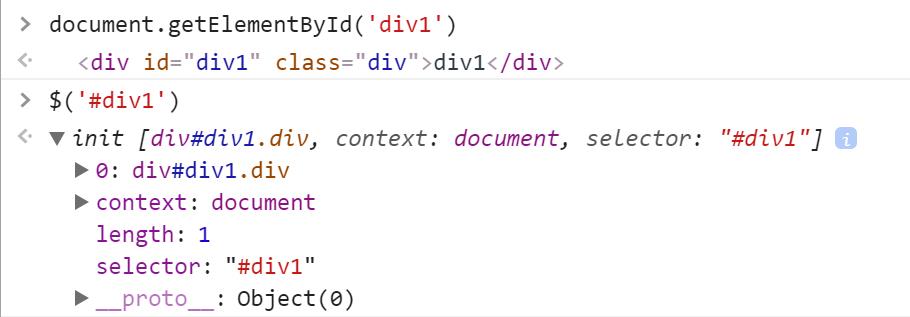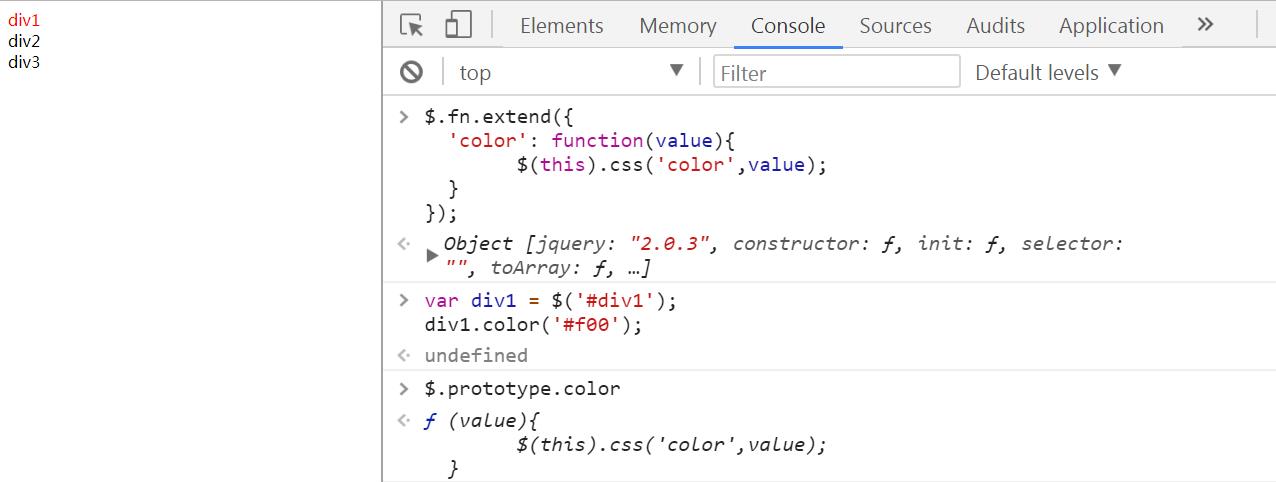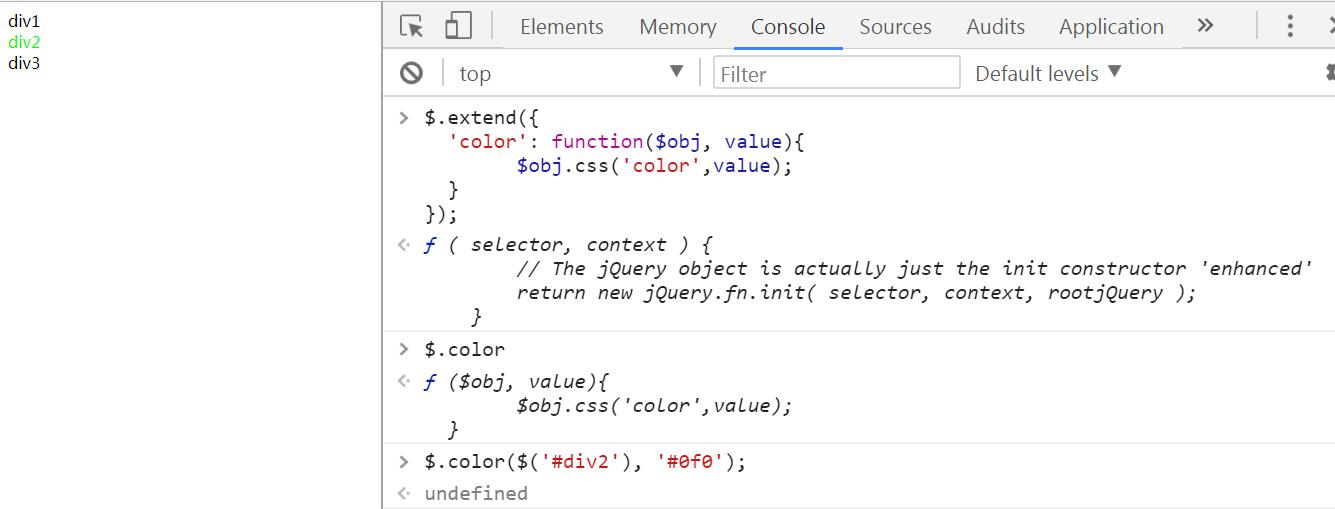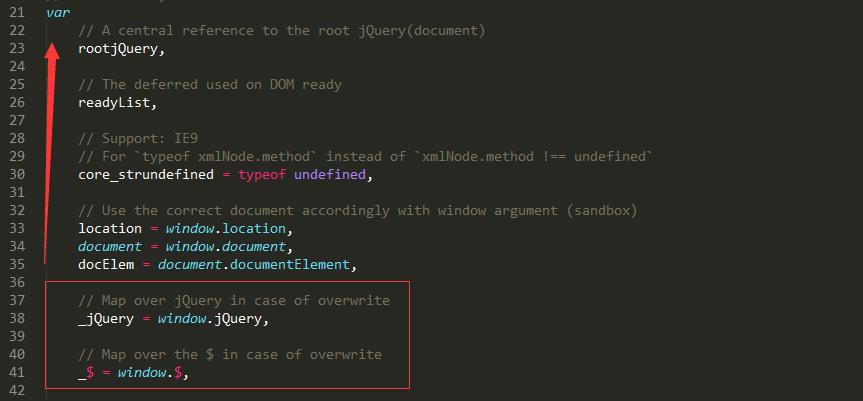jQuery.2.0.3源码分析01-整体架构思想
Posted yanmuxiao
tags:
篇首语:本文由小常识网(cha138.com)小编为大家整理,主要介绍了jQuery.2.0.3源码分析01-整体架构思想相关的知识,希望对你有一定的参考价值。
一、jQuery($)命名空间
为了避免声明了一些全局变量造成变量污染,使用立即执行函数形成jQuery($)独立的命名空间;
(function(window, undefined){ })(window)
二、jQuery的本质是什么?
(function(window, undefined){ var jQuery = function( selector, context ) { return new jQuery.fn.init( selector, context, rootjQuery ); }; })(window)
由jQuery的源码可知,jQuery的本质是一个函数(对象),是函数就应该有原型(prototype对象),但是,jQuery重置了该原型(prototype对象),也就是重新赋值,同时也将原型(prototype对象)赋值到jQuery的fn属性上,也添加了很多属性和方法,看源码:
(function(window, undefined){ var jQuery = function( selector, context ) { return new jQuery.fn.init( selector, context, rootjQuery ); };
var core_version = "2.0.3"
jQuery.fn = jQuery.prototype = { jquery: core_version, // 存放jQuewry版本 constructor: jQuery, // 构造函数
init: function( selector, context, rootjQuery ) { } } })(window)
三、jQuery对象是什么,也就是$()返回了什么?
我们都知道jQuery可以通过选择器获取DOM对象,但是jQuery返回的DOM对象和原生DOM对象(如通过document.getElementById获取的DOM对象)是不一样的,但是可以相互转换,如可以通过$().get()方法或者$()[]将jQuery DOM对象转换成原生DOM对象,也可以通过$(原生DOM对象)将原生DOM对象转换成jQuery DOM对象。
但是jQuery对象是什么($()返回了什么),如图用原生方法和jQuery方法获取一个id为div1的元素:

通过document.getElementsByClassName和通过$方法获取class为div的元素:


$()返回的值为什么是这样的呢?其实我们可以看源码$()的返回值也就是构造函数init的返回值:
(function(window, undefined){ var jQuery = function( selector, context ) { return new jQuery.fn.init( selector, context, rootjQuery ); };
var core_version = "2.0.3"
jQuery.fn = jQuery.prototype = { jquery: core_version, // 存放jQuewry版本 constructor: jQuery, // 构造函数 init: function( selector, context, rootjQuery ) { } } })(window)
返回值是执行一个函数,
return new jQuery.fn.init( selector, context, rootjQuery );
,是jQuery原型重置后原型上的一个函数,而且通过new创建的,那么其实$()的返回值也就是init这个函数的返回值。通过new执行的函数也就是构造函数的执行,init是一个构造函数(虽然首字母没有大写),也就是说jQuery DOM对象($()的返回值)是init构造函数的一个实例,该实例继承了构造函数init原型(prototype对象)上的所有属性和方法(构造函数init原型上有哪些属性和方法呢?,这一点很重要,先卖个关子)。我们先来看一下jQuery源码上构造函数init返回了什么:

1 (function(window, undefined){ 2 3 var jQuery = function( selector, context ) { 4 return new jQuery.fn.init( selector, context, rootjQuery ); 5 }; 6 7 jQuery.fn = jQuery.prototype = { 8 9 jquery: core_version, // 存放jQuewry版本 10 constructor: jQuery, // 构造函数 11 init: function( selector, context, rootjQuery ) { 12 var match, elem; 13 14 // HANDLE: $(""), $(null), $(undefined), $(false) 15 if ( !selector ) { 16 return this; 17 } 18 19 // Handle html strings 20 if ( typeof selector === "string" ) { 21 if ( selector.charAt(0) === "<" && selector.charAt( selector.length - 1 ) === ">" && selector.length >= 3 ) { 22 // Assume that strings that start and end with <> are HTML and skip the regex check 23 match = [ null, selector, null ]; 24 25 } else { 26 match = rquickExpr.exec( selector ); 27 } 28 29 // Match html or make sure no context is specified for #id 30 if ( match && (match[1] || !context) ) { 31 32 // HANDLE: $(html) -> $(array) 33 if ( match[1] ) { 34 context = context instanceof jQuery ? context[0] : context; 35 36 // scripts is true for back-compat 37 jQuery.merge( this, jQuery.parseHTML( 38 match[1], 39 context && context.nodeType ? context.ownerDocument || context : document, 40 true 41 ) ); 42 43 // HANDLE: $(html, props) 44 if ( rsingleTag.test( match[1] ) && jQuery.isPlainObject( context ) ) { 45 for ( match in context ) { 46 // Properties of context are called as methods if possible 47 if ( jQuery.isFunction( this[ match ] ) ) { 48 this[ match ]( context[ match ] ); 49 50 // ...and otherwise set as attributes 51 } else { 52 this.attr( match, context[ match ] ); 53 } 54 } 55 } 56 57 return this; 58 59 // HANDLE: $(#id) 60 } else { 61 elem = document.getElementById( match[2] ); 62 63 // Check parentNode to catch when Blackberry 4.6 returns 64 // nodes that are no longer in the document #6963 65 if ( elem && elem.parentNode ) { 66 // Inject the element directly into the jQuery object 67 this.length = 1; 68 this[0] = elem; 69 } 70 71 this.context = document; 72 this.selector = selector; 73 return this; 74 } 75 76 // HANDLE: $(expr, $(...)) 77 } else if ( !context || context.jquery ) { 78 return ( context || rootjQuery ).find( selector ); 79 80 // HANDLE: $(expr, context) 81 // (which is just equivalent to: $(context).find(expr) 82 } else { 83 return this.constructor( context ).find( selector ); 84 } 85 86 // HANDLE: $(DOMElement) 87 } else if ( selector.nodeType ) { 88 this.context = this[0] = selector; 89 this.length = 1; 90 return this; 91 92 // HANDLE: $(function) 93 // Shortcut for document ready 94 } else if ( jQuery.isFunction( selector ) ) { 95 return rootjQuery.ready( selector ); 96 } 97 98 if ( selector.selector !== undefined ) { 99 this.selector = selector.selector; 100 this.context = selector.context; 101 } 102 103 return jQuery.makeArray( selector, this ); 104 } 105 106 } 107 108 109 })(window)
源码有点复杂,因为jQuery的选择器功能也就是对DOM操作得功能非常的强大,我们先弱化jQuery的选择器功能,让jQuery只能通过id获取DOM元素,如,改写jQuery的源码如下:

1 (function(window, undefined){ 2 3 var jQuery = function( selector, context ) { 4 return new jQuery.fn.init( selector, context, rootjQuery ); 5 }; 6 7 jQuery.fn = jQuery.prototype = { 8 9 jquery: core_version, // 存放jQuewry版本 10 constructor: jQuery, // 构造函数 11 init: function( selector, context, rootjQuery ) { 12 13 var match, elem; 14 15 // HANDLE: $(""), $(null), $(undefined), $(false) 16 if ( !selector ) { 17 return this; 18 }else { 19 elem = document.getElementById( selector.replace(\'#\',\'\') ); 20 21 // Check parentNode to catch when Blackberry 4.6 returns 22 // nodes that are no longer in the document #6963 23 if ( elem && elem.parentNode ) { 24 // Inject the element directly into the jQuery object 25 this.length = 1; 26 this[0] = elem; 27 } 28 29 this.context = document; 30 this.selector = selector; 31 return this; 32 } 33 34 } 35 36 } 37 38 39 })(window)
由源码可以知道,返回值是 this 。这个this指的是什么?如果不知道可以去了解一下 new + 构造函数 的知识,其实通过new调用构造函数,构造函数中的this就是指向该构造函数的实例,在这里也就是指向init构造函数的实例。看一下具体是什么:

init其实也就是一个json对象,key值为0的value值是原生DOM对象,也就能解析为什么可以通过$()[0]就能将JQuery对象转换成原生DOM对象了。 init实例对象还存放了很多信息,如length、选择器、上下文document,其实在实际的jQuery中,$()传入的参数不同,init存放的信息也各不相同,自己可以去了解一下,比如上图,$的参数为空和传入id,init实例的数据就不同,又比如传入class和id又有所不同。
尽管$方法传入的参数不同,init实例也有所不同,但是有一点是相同的,也就是都继承构造函数init的原型对象,如:

我们都知道,jQuery对象有很多方法,如$().attr、$().addClass、$().removeClass等等.......,这些方法哪里来的呢,很明显是通过继承构造函数init原型上的,那么构造函数init原型上为什么有这些方法,按理来说构造函数是既然是一个函数,那么它肯定是继承了Object原型上的方法,但是Object原型上又没有这些方法,哪里来的呢?请往下看。
四、重置构造函数init的原型对象
上jQuery源码,看构造函数init的原型对象:

还有上面提过的:

也就是这样:

也就是说构造函数init的实例继承了jQuery原型上的所有属性和方法,同时将init实例的构造函数指向jQuery(造假技术一流),如:

在所有的jQuery对象中都可以找到jQuery的版本号和构造函数,同时也能解释为什么jQuery对象上面会有这么多的方法了。

五、jQuery插件机制
jQuery为开发插件提拱了两个方法,分别是:
jQuery.fn.extend(object); 给jQuery对象添加方法。
jQuery.extend(object); 为扩展jQuery类本身.为类添加新的方法,可以理解为添加静态方法(工具方法)。
这两个方法都接受一个参数,类型为Object,Object对应的"名/值对"分别代表"函数或方法体/函数主体"。看源码:
jQuery.extend = jQuery.fn.extend = function() { var options, name, src, copy, copyIsArray, clone, target = arguments[0] || {}, i = 1, length = arguments.length, deep = false; // Handle a deep copy situation if ( typeof target === "boolean" ) { deep = target; target = arguments[1] || {}; // skip the boolean and the target i = 2; } // Handle case when target is a string or something (possible in deep copy) if ( typeof target !== "object" && !jQuery.isFunction(target) ) { target = {}; } // extend jQuery itself if only one argument is passed if ( length === i ) { target = this; --i; } for ( ; i < length; i++ ) { // Only deal with non-null/undefined values if ( (options = arguments[ i ]) != null ) { // Extend the base object for ( name in options ) { src = target[ name ]; copy = options[ name ]; // Prevent never-ending loop if ( target === copy ) { continue; } // Recurse if we\'re merging plain objects or arrays if ( deep && copy && ( jQuery.isPlainObject(copy) || (copyIsArray = jQuery.isArray(copy)) ) ) { if ( copyIsArray ) { copyIsArray = false; clone = src && jQuery.isArray(src) ? src : []; } else { clone = src && jQuery.isPlainObject(src) ? src : {}; } // Never move original objects, clone them target[ name ] = jQuery.extend( deep, clone, copy ); // Don\'t bring in undefined values } else if ( copy !== undefined ) { target[ name ] = copy; } } } } // Return the modified object return target; };
可以看到这么一句:
jQuery.extend = jQuery.fn.extend
同时指向一个函数却实现不同的功能,可以思考一下为什么?其实很简单,加上函数里面this的指向问题,如果是jQuery.extend({}),函数里面的this指向的是jQuery,如果是
jQuery.fn.extend({}),函数里面的this指向jQuery.fn,这样就能知道到底是往jQuery拓展类本身添加方法还是往jQuery的原型上添加方法同时继承个jQuery对象了。
方法就是往jQuery.prototype上添加方法,如:

向jquery拓展类本身添加工具方法,如:

六、$.noConflict()
看源码,这里jQuery命名空间最底部的一段:

个人觉得这是一种不使用return方式形成的闭包方式,return方式是函数执行将返回值赋值到一个全局变量上,而jQuery的做法是直接在里面赋值都window上,其作用是一样的,如果使用return方式,return jQuery到外层全局变量也是可以的,但是,jQuery作者为什么没有这么做呢?其实有很深沉的含义在里面,window.jQuery和window.$也可能造成变量污染,比如和prototype库中的window.$形成污染(或者同时引入jQuery的不同版本),那该如何解决呢?那就的靠jQuery.noConflict()来解决了。解决冲突是有前提的:
1、其他使用jQuery、$变量的库必须在引入jQuery之前引入。(因为如果在jQuery之后引入,就直接覆盖了jQuery了)
那么jQuery是如何解决和其他库的冲突的呢?看源码:

在jQuery命名空间的顶部先把全局作用域window中的jQuery和$先赋值给jQuery命名空间中的局部变量存放起来(如果不存在,_jQuery和$的值就是undefined),如果存在冲突,那么再使用jQuery或者$之前,先执行$.noConflict(),可以看源码这个函数做什么了:

如果全局作用域中(window上)的$和jQuery命名空间上的jQuery是全等的,那么将全局作用域中(window上)的$赋值给命名冲突库中的$(已存放到_$中),如果deep为true,说明jQuery也有冲突,也将jQuery从新赋值给命名冲突库中的jQuery(已存放到_jQuery中),最后return jQuery,我们可以对jQuery中的$重新赋值,如:

在不存在冲突的情况下执行了$.noConflict()后,$不能再使用,它的值是undefined。至此,可以说jQuery实现了对全局作用域的零变量污染。
七、总结
1、jQuery的本质是一个函数,但是不作为构造函数使用,而是返回 一个构造函数init的实例,也就是jQuery对象。
2、jQuery函数重置了它的原型(prototype对象),重新定义,同时作为返回值的构造函数init的实例的原型也被重置,指向jQuery的原型,所有构造函数init的实例继承了jQuery原型上的所有属性和方法。
以上是本人的一下理解,有错欢迎指出,网上有很多分析jQuery源码的,更多请参考:
1、https://www.zhihu.com/question/20521802
2、by Aaron:http://www.cnblogs.com/aaronjs/p/3279314.html
以上是关于jQuery.2.0.3源码分析01-整体架构思想的主要内容,如果未能解决你的问题,请参考以下文章
